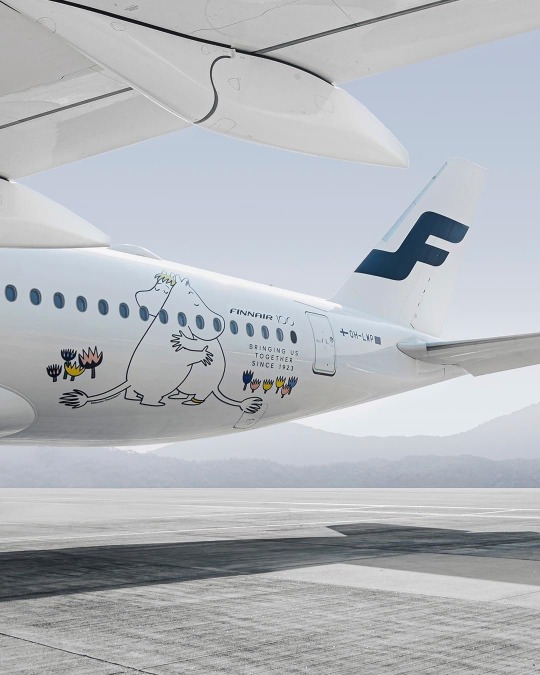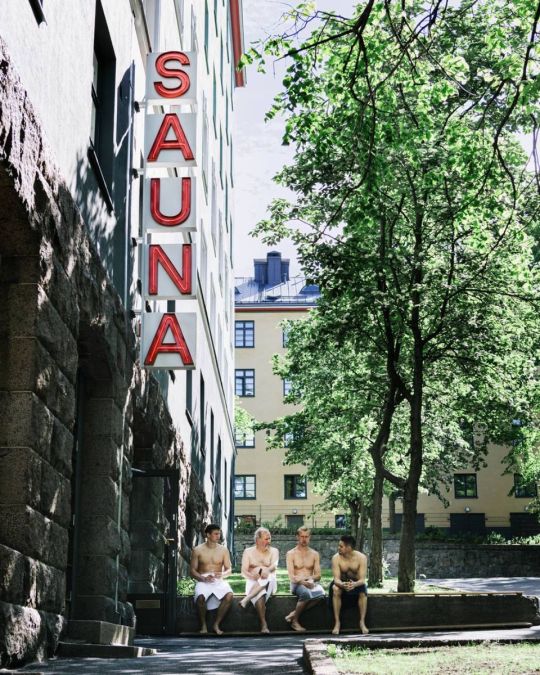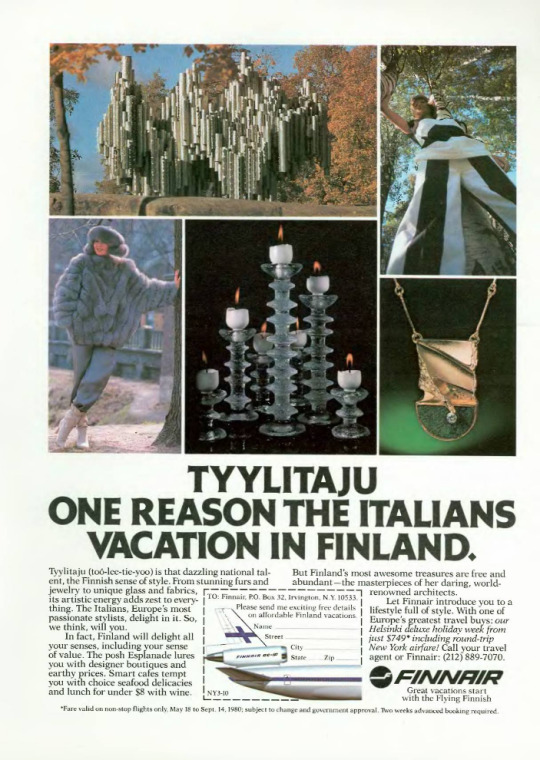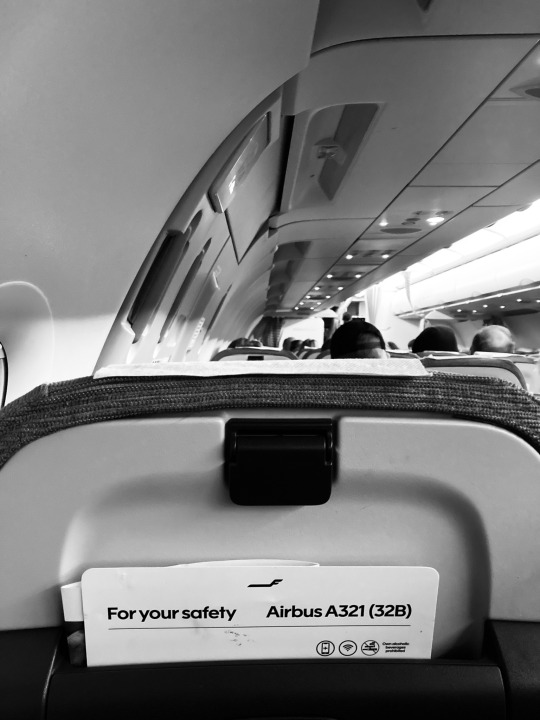#Finnair
Text

A Moomin livery on the Finnair MD-11 plane that flew Helsinki-Tokyo route in the past.
5K notes
·
View notes
Text
No. 55 - Finnair [+ Centenary Livery]
So I know I'm in the process of writing a bunch of longer posts and thus haven't posted in absolutely forever, but I had to let something cut the line very quickly because in this case it was somewhat time-sensitive. I've missed the actual date by two months, but if I get in a post while it's still 2023 (...in my timezone, at least, so sorry to actual Finns busy enjoying 2024) I think that counts, and this entire blog is about what I think, so that means it counts.
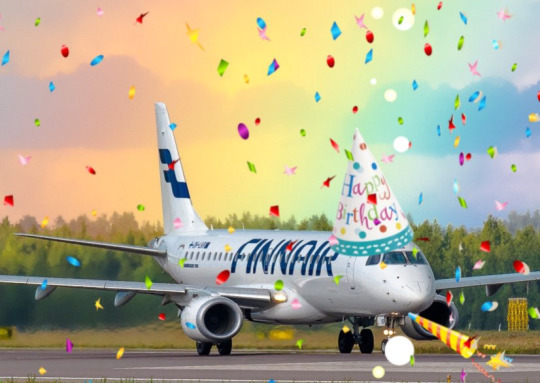
On 1 November 2023 Finnair became the sixth airline to turn 100 years old, consistent with its status as the sixth oldest airline in continuous operation. I wish I'd started this blog earlier in the year, or prioritized differently, because Aeroflot and Czech Airlines also turned 100 in 2023, but...well, I didn't. You'll probably see them both in 2024 instead. Finnair, however, was requested by @kuivamustekala - particularly their centenary liveries. Requested a long time ago, even. So I'm going to hope that late is better than never and throw Finnair one last birthday party to wrap up 2023 by looking at where they started, where they are now, and what they've been doing to celebrate.
1923: PROTO-FINNAIR
Finnair, obviously the flag carrier of Finland, was founded in 1923, but its first service was in early 2024, using a Junkers J.13 (fitted with obligatory floats, as there were no suitable airstrips in Finland at the time).
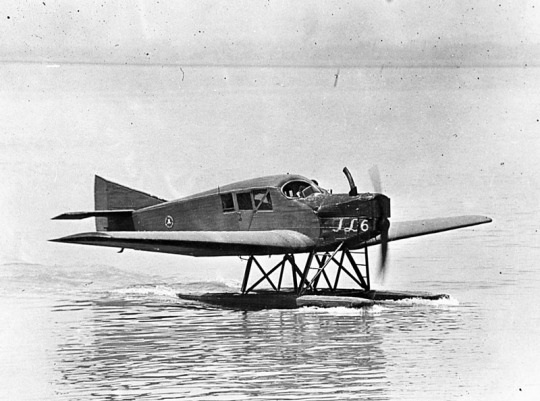
image: Joseph Eaton via US Navy National Museum of Naval Aviation
This is actually the US license-built version, the Junkers-Larsen JL-6, but I couldn't find any pictures of actual J.13s on floats.
Unfortunately, Finnair was founded under the name 'Aero', which is probably the actual single worst name for an airline I have ever heard. We can jest and joke about things like Jet2 and Fly Air, but I sincerely do not think I have ever seen anything with worse SEO than an airline named 'Aero'. Even for 1923 this was fairly dire - back then, as for much of history, airlines were generally named for the area they served. Aero may have been a private company, rather than state-owned, but that didn't mean they couldn't name themselves for the area they served - private airlines have always done this and still do. Incredibly enough, there was a second 'Aero' founded in Poland in 1925, but that was quickly merged into what would become LOT Polish Airlines, shedding the name like a chrysalis.
Bafflingly, even when the Finnish government bought the airline in 1946 (they still own a majority share of it today) they didn't bother to change the name. They did begin writing 'Finnish Airlines[1]' on the fuselages, but as far as I can tell this appears to have been more of a stylistic flourish of sorts than an actual rebrand, or maybe even a clarifying subtitle on the very nonspecific name. In 1953 they began marketing under the much catchier 'Finnair', but the company remained legally named 'Aero' until literally 1968 and the fuselages still read 'Finnish Airlines'.

image: Finnair
An Aero/Finnish Airlines Convair 340, photographed in 1953 in a livery which included both the large 'Finnish Airlines' wordmark and 'Aero' on the tail.
Early Finnair, like most early airlines, didn't have a particularly standardized livery for its fleet, and even where it did it's not very well documented. Finnair unfortunately has some of the poorest documentation for livery evolution of any large airline I've discussed so far, which really surprised me. That said, it's when the name became Finnair that things begin to be easier to find, and so that's where I'll begin.
1968: CLASSIC FINNAIR

This original logo[2], introduced in 1968, was designed by Kyösti Varis - at least, that's what every logo database I looked in said. I actually couldn't find either Finnair or Varis confirming this[3], but I still think it's probably true. Unlike designers like Vic Warren and Lindon Leader, who wrote and gave interviews about their designs for major airlines, Varis appears to have other preoccupations. He is enormously successful and prolific, to the point where his website doesn't even mention Finnair. According to the timeline he provides he would have either been creating this logo freelance or in his very last days at Advertising Agency SEK (probably the latter, since they did the two subsequent iterations), and based on his history as a typographer I think it's safe to say the letterforms are his creation as well. Also according to his timeline, he is younger than Finnair! And we almost have the same birthday.
I like the original Finnair branding. It's not ostentatious, but it's nice and sleek, with that forward slant I love in airline branding and a long unbroken line (both in the 'F' logo and in the even heights of the letters in the wordmark). It looks aerodynamic and the rounded, blocky letters have a hint of that 60s futurism while not being gimmicky. It's kind of incredible looking at it next to the '91-'94 FedEx wordmark, which occupies the opposite end of the sliding quality scale of TRON-looking text. The design as a whole is simple enough to easily reproduce but distinct enough to easily recognize. The shade of blue chosen is a fair bit lighter than the blue of the Finnish flag, but visually pleasing enough. They basically keep iterating on this general concept for the rest of their history, which I think is fantastic - no need to get rid of something that's working for you. It's nice to see an airline not feel pressured to reinvent its logo and livery every 20 years. That's about it for the logo[4] - what about the livery?
As mentioned prior, Finnair's liveries, before quite recently, were very poorly documented. Variants definitely existed between different types and different periods in the company's history, but the broad strokes of the branding seem to have remained almost startlingly intact for around thirty years.

image: Letterform Archive
The cover of a style guide from 1985. If it's changed from the 1968 original, I can't tell how.
But I'm really here to talk about one thing: the liveries.
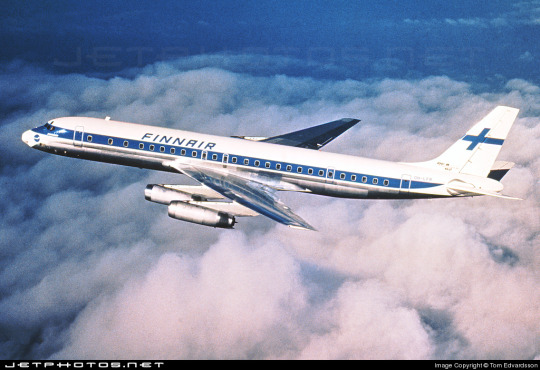
The above image was from Finnair's own archive and was taken in 1968[5], making it contemporary with the introduction of the Kyösti Varis branding, as well as lining it up with the 1969 addition of DC-8s, like the pictured airframe.
For the majority of Finnair's history, their livery is always going to look something a little bit like this. Primarily white, with a thick blue cheatline (in what I call the domino-mask style, where it's vertically centered around the cockpit windows) that lightly flips up at the very end and a blue cross on the tail to represent the Finnish flag.
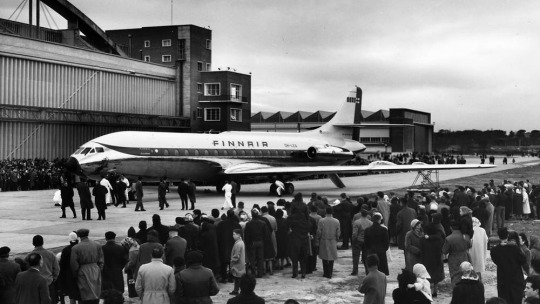
Finnair says this image is from 1960. If so, the livery was already well on its way to existing prior to 1968, with my guess being that it was introduced in 1960, along with the first jets in Finnair's fleet - the pictured Sud Aviation Caravelle, which pioneered the swept-wing, aft-engine format later seen on immensely popular jets like the DC-9 and Tu-134 - the latter of which was commissioned specifically because Nikita Khrushchev was so impressed with the Caravelle's aft engines and the quiet cabin experience they provided. It's a plane with a lot of unique visual features, featuring a nose that looks almost slanted downwards (a copy of the de Havilland Comet nose), a cruciform tail (instead of the more efficient T-tail used for future rear-engined designs), and triangular passenger windows. Most crucially, though, it was more or less the first short-range jet on the market. This made it perfect for an airline like Finnair, which at this point didn't really go that far from actual Finland.
This 1960 photograph provides a very strong blueprint for what was to come. It's the first iteration of the livery to say 'Finnair' instead of 'Finnish Airlines', and it's introduced a modern-for-1960 single-rule cheatline, although this early version was flipped horizontally, curling up at the front to frame the cockpit windows instead. (I think the white paint also cuts off behind it, leaving the space in-between the cheatline and painted nose blank metal, but in black-and-white it's somewhat hard to tell.) I do think I prefer the modern version. The use of the white downward curve with no blue hemming it in creates a really nice effect where it blends with the unpainted metal underside, due to the metal being right where you would expect to see a shadow anyway. (This effect is why I'm not quite sure where the paint ends on the Caravelle, and am just guessing based on which parts are noticeably reflective.) I definitely prefer the change made to the tail, where the single line of trim at the end of the rudder was replaced with a white canvas for the Finnish flag.

While I do tend to have a slightly pessimistic outlook on primarily-white liveries, I will say that if you're going to have a primarily white plane, and you are the flag carrier of Finland, this is a fairly understated and stylish way of incorporating it. While I probably would have done it on the main body, over where the first set of doors is, instead of on the tail, I think this is far from the end of the world. What they have is a nice, elegant taper where the tip seems to point directly at the tailplane, and it looks neat and intentional. A lot of airlines tend to just awkwardly slap a logo on their tail, which often looks really sloppy due to poor alignment or even just out-of-place entirely, and Finnair avoids that while keeping the tail from being completely blank. Having an element on the tail that's more horizontal than vertical, like the old 'AERO' rectangle or the tail rectangle on the one decent livery Lufthansa ever had.
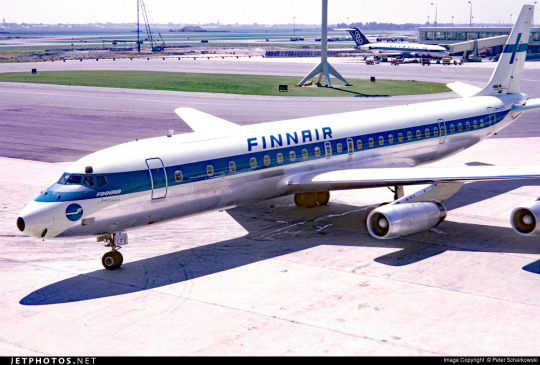
If you look in the background, you can see that wow has the Olympic Air livery looked like that for a long time! But that's a story for soon.
Additionally, some details were added on the nose. You can see on this DC-8, photographed in 1969, that the nose features an e-girl cheek stamp of the Kyösti Varis logo. Next to it is the name of the aircraft - in this case, Jean Sibelius - in really difficult-to-read thin text. (Finnair unfortunately appears to have stopped naming their planes by the late 1970s, but at one point they would frequently be named for Finnish people and places.) The 'domino mask' goes quite a bit beyond the cockpit windows to create a wider line from the side. I wish that the logo could have been integrated some other way, because the extra little blue thing just looks cluttered, but I can't imagine how they would do it without just replacing the cheatline. I mean, that would have been an option - indeed, it's what I would have done[6] - but assuming that they keep this general look I think the logo just can't fit in on the livery. The engine nacelles, maybe? Though that would still present issues on the Caravelle, where the engines are directly over the cheatlines. I also wish they would have made it a bit easier read the name, because I like to know what the plane's name is - thankfully, some later paint jobs actually do this before, tragically, Finnair stops writing names on their planes at all.
I believe this to be the strongest iteration of the classic Finnair livery, and it was pretty obviously optimized for the DC-8. Modern airlines tend to not bother adjusting their liveries between types, creating some absolute travesties of proportion, but Finnair boldly went in the opposite direction by modifying it for each airframe and yet still having it look worse.
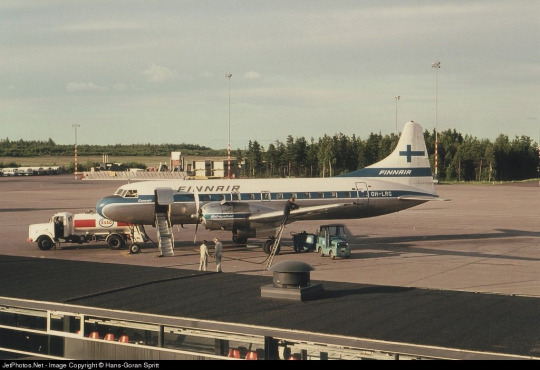
The sharpest deviation arises in the CV-440 version of the livery. This image is from 1971, just two years after the DC-8 liveries would have carried their first passengers, and it's wildly different. The cheatline is lowered sharply, sitting below the cockpit windows and wrapping around to contour the body of the airplane. There's a certain je ne sais quois to the domino mask that I find myself missing here. This design also has an unnecessary second 'Finnair' added to the tail, which kind of looks awkward stacked on top of the existing cheatline besides being redundant, and the Finnish flag on the tail is somewhat awkwardly made free-floating. It feels a lot less sleek and a lot more arbitrary.
On the other side of the plane the cheatline goes down quite a bit farther than on the jet models, probably because they thought it would be a better way of negotiating the Convair's rather bulbous nose, and I actually think I prefer the wide, upturned variant. This version, if anything, is too close for my taste to the livery VARIG operated in a similar timeframe. There are a lot of differences, yes, but in the 70s having one big solid cheatline on a white body and metal underbelly was the equivalent of the Lufthansa Line, so if you toed said line, be it cheat or Lufthansa, you risked becoming easily mistakeable for any airline with too similar of a color scheme. And blue-on-white was maybe the most common color-scheme at the time.
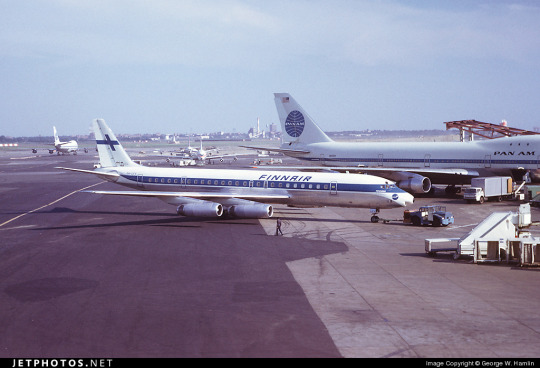
I doubt Finnair shared many tarmacs with VARIG, but here they are with Pan Am, and they could also expect to run into airlines like Sabena, Icelandair, and probably a half-dozen I've never heard of, all competing to be the one the others get mistaken for. It's a tricky position to be in.
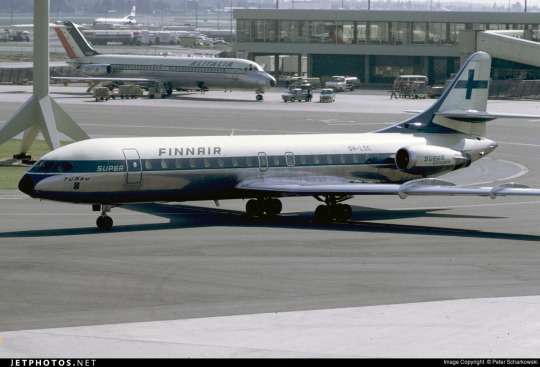
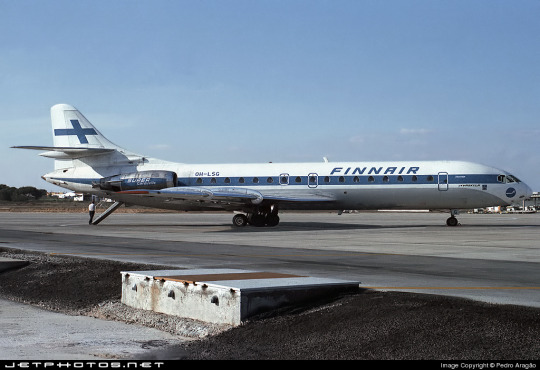
I do quite like the livery on the left, maybe even more than the DC-8 one, but I can't seem to find any other airframes painted like this. I'm not sure why this one is.
These images are from 1971 and 1969. They are both the same model of airplane - the Super Caravelle or Caravelle 10B. Their liveries are completely different. And that's just how it was back then - not even standard within the same airline, somehow still trying to stay distinct from dozens of other non-standardized blue-on-white cheatlines.
When evaluating classic Finnair, I have to keep myself tempered in both directions. When I think it's clean and well-proportioned I have to remind myself that it's just a complete nothingburger. When I think it's a lazy and cowardly non-design I have to remind myself that, no, at its best classic Finnair does look like it was designed with some thought, and it does have some traits that feel at the very least interesting enough to merit not being totally dismissed.
But...look, I have to give classic Finnair a D+. Because they tried, and they did something, sure, but it's ultimately not something especially memorable and the implementation is just spotty.

Even given a canvas like the DC-10, they fumbled. The DC-10, in my opinion, was a big test for them. And I do mean big. In the DC-10 is a plane with all the space in the world to add visual elements, and a space where just a couple lines can go from a detail to a fin that towers over anything that isn't a 747, showing off the Finnish flag as if someone had flown it from a building mast. The third engine, which I feel like a lot of airlines really struggle with on the DC-10, gets a nice horizontal line of writing that's not intrusive but helps prevent it from feeling like a giant gap. The wordmark gets larger, is moved forward, gets to really own the space it takes up instead of being squeezed in. And...they made the cheatline just....a really thin flat line that looks bad and stiff and boring. There's nothing setting them apart from Icelandair, and Icelandair's livery from this point in time was so boring that my only comment on it was that it looked like they forgot to paint the rest of the plane. You can do white planes well, but Finnair just really doesn't get there.
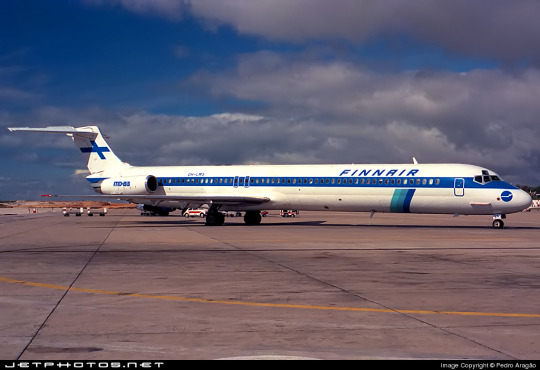
...hey, Finnair? You can't just decide to do belly stripes but worse, Finnair, you're literally next door to like two thirds of SAS and that livery was designed from the ground up. They have a couple of near-misses with SAS's toes but this is the one that makes me actually go 'is this allowed?'. It seems to have been exclusive to their late-80s MD-80 fleet, but it's just incredible to me that it ever happened. (That said, those three shades of blue are so nice together and I wish they had ever brought them back. I understand the appeal of sticking to the stark contrasted blue-on-white of the flag, but there's so much potential out there!)
1997: NEW TYPE, NEW LIVERY

I really like the 757. It deserves a better livery than this.
Removing the cheatlines was a very trendy choice to make. This is the sad beast I call the Deltalite - a Deltalike but without the painted nacelles and belly that are usually slight redeeming factors. There's such a beautiful design on the tail that could have been put on the whole fuselage, honestly, and that's sad, but even on the most granular of levels...why keep the little cheek stamp if you have the logo visible on the tail now? Weird choice. Being so desperate to do the Deltalite thing everyone else is doing that you get rid of your country's flag on the tail is just a bad choice of priority, I think. There's not much to say about this. Honestly, I'd drop it to a D-. There's enough happening that it would lose something by being painted into Star Alliance colors, but it wouldn't lose terribly much.
2000: NEW FINNAIR

Oh, Finnair. Why? Did no airline resist the siren song of getting way too into airbrushing in the early 2000s?
Maybe I just have whatever the opposite of nostalgia is for the early 2000s, but this just makes me sad. They've made the wordmark look worse, overcomplicated the simplicity of the logo, and gone ham with the gaussian blur.

Look, it's not all that bad. The shades used on the actual plane are noticeably darker, and the colors at least don't look half bad now. And they've even bothered to paint the engines this time around! But...come on. You've changed 30 years of something that was working just fine for...this? Something which maybe climbs up to a flat D?
The 2000 brand overhaul, including the logo, was done by Finnish agency SEK & Grey. They're nearly as old as Finnair and have worked for brands as prominent as Coca-Cola and Kellogg's, but their about page puts Finnair front and center. They have an entire page describing their Finnair work.
Despite claiming to have included humanity and warmth and movement, I see none of this. I'll admit upfront I generally dislike what's dubbed 'Nordic' design. It's not the minimalism which I dislike but the banality.

What does any of this have to do with Finnair? What here represents the history of one of the world's oldest airlines? What here really speaks to the Finnish people? Why is just designing something generic and making sure it's all crisp (when you're photographing it fresh out of the plastic, before it's been tripped over and stepped on and yanked down staircases and accidentally sat on and stained with tea) considered a substitute for designing something that people will see years down the line and get nostalgic for? I'm nostalgic as hell for Alitalia, an airline that doesn't exist anymore. I still use the bag from an amenity kit I got on Alitalia nearly ten years ago to store small essential things like toothbrushes and medication while traveling, but I wouldn't know it was Alitalia by looking at it, because it's lovely and convenient and ergonomic but it's literally just grey. It evokes nothing, and it doesn't even say 'Alitalia' on it anywhere. Nothing here could ever be considered ephemera or memorabilia. I could steal Finnair's look at the Gap.
2010: SORRY, HERE'S NEW FINNAIR FOR REAL THIS TIME

SEK & Grey gave it another shot. This one's a lot better.
I like the change in the logo, first off. And this, the word 'Finnair', is the logo, but I'm comparing it to the earlier wordmark. 2000's attempt felt like it was taking the original and just trying to sand off the corners to make it more modern, but the 2010 take on it actually shapes each glyph into a neat little space-age thing that creates this curved shape by way of a lot of straight lines, in a way that feels visually pleasing and interesting. I enjoy the square holes in the A and R, the return of the crossbar on the N, and the extreme range of widths which gives the letters a real weight to them. This isn't a typeface - these glyphs exist in the context of the word FINNAIR in this exact configuration and one of four colorways. Finnair does have a proprietary typeface, Finnair Sans, and it looks nothing like this because this is not a font, it's a logo.
I think it is a shame that this is the logo now. I really liked the F. And they haven't gotten rid of it, but it's now been relegated to an official subordinate position, according to their branding guide:
The official Finnair logo is the text version of the logo, and it is primarily used. The F emblem is used as an additional symbol.
Look, I'll always think it's a shame when your main logo is just the name of your company. Some airlines do it, and it feels like an empty space to me. It can be satisfactory but not outstanding. When you start out with a nice little symbol and then take it away, though, I do feel somewhat robbed.

It stings extra because I really like the way the new F looks. It has that long brushstrokey look and it almost makes me think of Hebrew characters. The way it tapers now really adds to the feeling of movement I get from it, and it's a great base for a livery. Now that it's darker, even though this does bring Finnair into competition with airlines like SAS, LOT, TAROM, Lufthansa, and even Ryanair when it comes to dark-blue-on-white, it also contrasts better with the main body, and it's still light enough that you can recognize it as blue. Anyway, it doesn't take a genius to know how to integrate this into a livery. Long line for the fuselage, go up to match the tail...
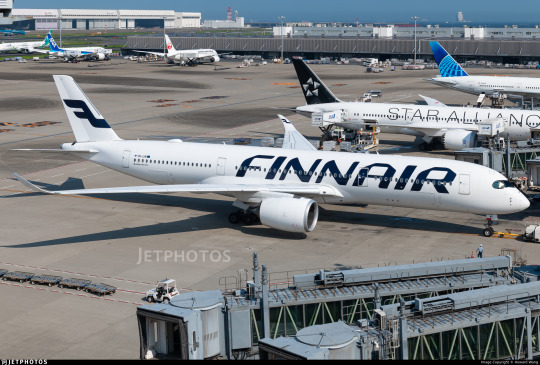
Finnair. Are you serious, Finnair?
Look! I get it! Billboards are in now, it's fine, I get it. it's probably the nicest billboard I've seen in a while, font-wise. It feels comfortable on the fuselage and it feels like it earns the space it occupies. The F is nicely centered on the tail, cuts off at a pleasant point. But...why?
I really can't be too mean about this. I want to be meaner than I actually can justify, because I think if any other airline made their plane this featureless I would hate it but Finnair's billboard livery is actually nice enough and everything is placed well enough that it's not at all unpleasant to look at. It's an acceptable livery. If maybe 25% less planes were basically all white it would shoot up in my esteem. I don't really like the fact that they put the little Fs on the inside of the wingtips of their A350s, but that's really my only nitpick. It's just sort of...bringing a really fantastic loaf of bread to a potluck when you were asked to bring baked desserts. You've done a very good job, but you didn't quite get the assignment.

It's a bit hard to critique the modern Finnair livery in detail because I think it's executed fine. There's nothing really wrong with it except that it has a logo that could lend itself to all sorts of interesting shapes, it has 30 years of variants of a very specific design to draw on, and it's chosen to go tabula rasa just to be all clean and minimal instead of doing any of the interesting things it could have with this new start.
I want to dislike this take on the Finnair livery, but at the end of the day I just don't. I think it's completely satisfactory. A lot of airlines try to get this look and somehow end up seeming cluttered for it. Finnair is one of the only instances I can think of where a white fuselage with just a wordmark has looked okay. It isn't ugly. It hasn't failed at the thing it's trying to do, but I think that it should have tried to do something else.
At the same time, though, this is the most Finnair that Finnair has ever been. The blue cheatline and the Deltalites were stumbling over well-trod ground. The modern livery, at least, isn't sloppily tail-heavy and seemingly thoughtless.
I give modern Finnair a C. This took an excessive amount of deliberation, but it really is...good enough. It's satisfactory. It's fine! I would have taken a completely different direction, but they have done a good job with their sort of lackluster idea. It's alright. We'll check on them again in another hundred years and see where they're at.
2023: CENTENAIRY
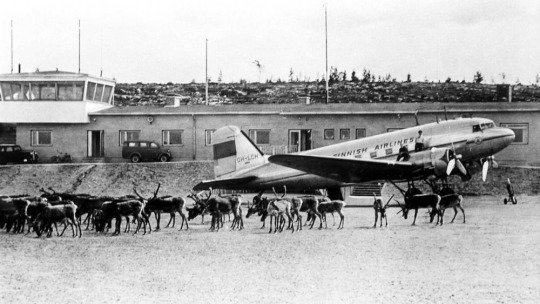
A century is a very long time. Finnair is older than my oldest grandparent. Finnair is older than over a dozen sovereign countries. Finnair is older than aerodromes in Finland. It's older than every currently operating airline except KLM, Avianca, Qantas, Aeroflot, and Czech Airlines. As of the first of November, Finnair is in triple digits.

I adore this centenary stamp Finnair has put out, celebrating the long relationship between aviation and the mail. It's not complex, but it's not barren, either. It combines the dark blue of the modern livery with the light blue of the classic one, all with the white silhouettes of airplanes elegantly soaring over an outline of Finland. The outstretched white wings on the deep blue have the grace of a giant fish swimming beneath a glass-bottomed boat.
But of course it isn't just stamps. Finnair is an airline. Airlines do special liveries. Qantas and KLM both slapped a big 100 sticker on an airplane for their big anniversaries. Finnair has of course done something similar.

Three airframes - the pictured A350-900, OH-LWR, and two A320s - OH-LXK and OH-LXM - have had a 'bringing us together since 1923' sticker applied. Matching the rest of Finnair's branding, it's certainly quite minimal, but it's a nice gesture. It's not what people have been talking about. That's OH-LWO and OH-LWP, both A350-900s, who have been given something more substantial to wear.
youtube
I'm going to assume that after its renaissance on tumblr a few years back most people reading this are familiar with the Moomin franchise. I definitely am, because when I was in my larval stage my mother first taught me to read Russian using an omnibus book of Moomin stories. Creator Tove Jansson apparently designed both the shape of the eponymous white critters and the sound of the name Mumintrollen itself are designed to evoke a feeling of softness, and it's clear why these characters are so beloved.
It isn't the first time Finnair, which frequently collaborates with Finnish brands and highlights its Finnish roots, has featured Moomins.
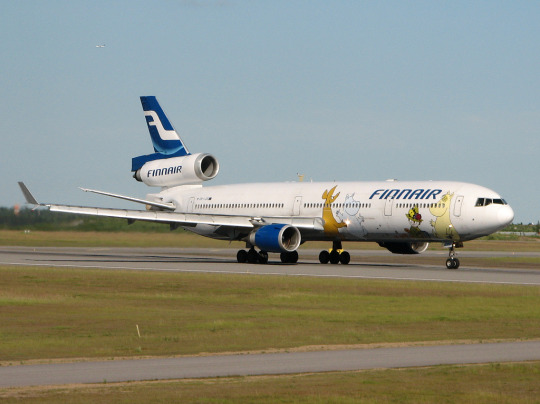
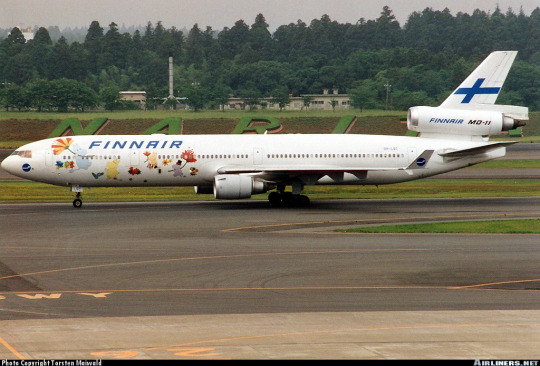
image on left: Antti Havukainen
In the 1990s, the airline first flew a Moomin jet. They had another in the 2000s. Both were withdrawn from service before 2010. It's been a while now since Finnair flew their last MD-11, but when celebrating their 100th birthday, a milestone that the vast majority of airlines will never see, they chose to do it by way of a soft Moomin embrace.
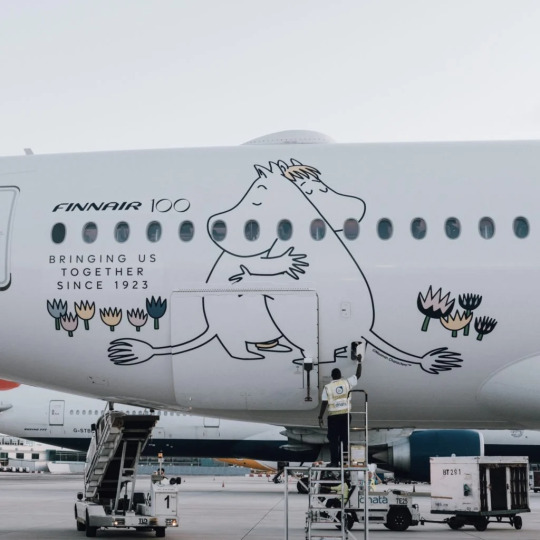
image: Changi Airport
And, I'll be honest, I think it's very sweet. It got an actual, sincere little smile out of me.
100 years is a really long time. In 1923 aviation was unrecognizable. What we would now consider an airliner didn't really exist yet - space for ten passengers, closed cockpits, and metal fuselages were the exceptions rather than the rule, and the Ford Trimotor was two years from its first flight. Cabin crew were barely even a concept. Airplanes, for all intents and purposes, were considered a type of boat. A nonstop flight across the Atlantic was a ridiculous concept. In a report published by the US National Bureau of Standards, it was said: 'there does not appear to be, at present, any prospect whatever that jet propulsion of the sort here considered will ever be of practical value, even for military purposes'. There were no aerodromes in Finland, so a small company called Aero attached floats to a plane just large enough for four passengers and took them from Helsinki to Tallinn.
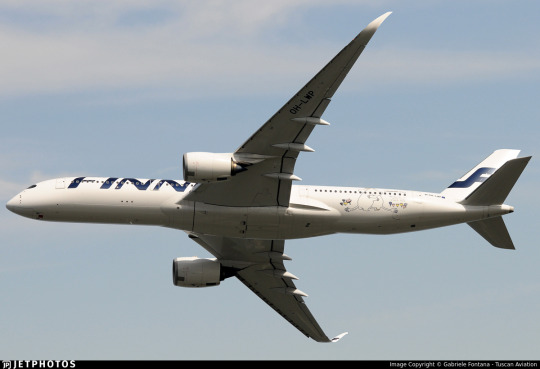
Look how far we've come.
Footnotes:
[1]: The Finnair website's history page, which I used as a source for much of the background and several images in this post, renders it as 'Finnish Air Lines', but on the airplanes themselves it clearly has no space, so I've corrected that seeming error for them. I don't know why this discrepancy exists, because as far as I know during this period they were marketing themselves as Aero so this text would only have existed on the livery itself.
[2]: Actually, I very occasionally see this version where the F logo isn't fully surrounded by the circle and the F in the wordmark doesn't have the rounded top, and I don't know which came first or if the less round version is just somehow...not real? I did try to figure this out, I swear, but at some point I realized I am literally not a professional logo historian, and nobody is going to be let down if I don't brute-force an answer despite not even speaking Finnish, and I should finish writing the post before it's 2024.
[3] The closest thing to an official source I can find is the descriptions of two listings for the centenary stamp including a quote from designer Ilkka Kärkkäinen attributing it to him. I don't at all doubt that he did design it, but I always like to find concrete attribution for things if I can and would hate to spread misinformation and the sparseness of confirmation here is something I find very strange. My best guess is that there's plenty of good sources on it in Finnish but nobody has bothered to make it as clear in English.
[4] Admittedly this is a stretch, and I certainly don't think it was intentional, but it does remind me of the longship prow used in early SAS liveries. This motif was introduced in 1946 and continued to see use after the Finnair logo was introduced. The overlap is fairly limited in that SAS never used the longship in their logo (...I kind of want to talk about their logos one of these days) and the Finnair livery you'll see shortly doesn't look like SAS's at all, plus SAS has the extra pink on their liveries, but I couldn't get it out of my head that they do look sort of alike.
[5] The absolute hero who uploaded it to jetphotos mentioned that Finnair had given him the photograph while planning to dispose of it, and this makes me wonder if the lack of documentation is just because Finnair doesn't hold onto their old materials, which makes me very sad. A lot of companies, more broadly, didn't bother to keep records until somewhat recently, but in Finnair's case it seems to be particularly egregious. As someone literally studying to be an archivist it makes me exceptionally sad to see history lost just because nobody cared enough to preserve it.
[6] Maybe they didn't want to look like backwards SAS. Who can say?
#tarmac fashion week#finnair#grade: c#grade: d+#region: finland#grade: d#grade: d-#region: northern europe#era: 1960s#era: 1970s#era: 1980s#era: 1990s#era: 2000s#era: 2010s#era: 2020s#special liveries#commemorative liveries#requests
50 notes
·
View notes
Photo
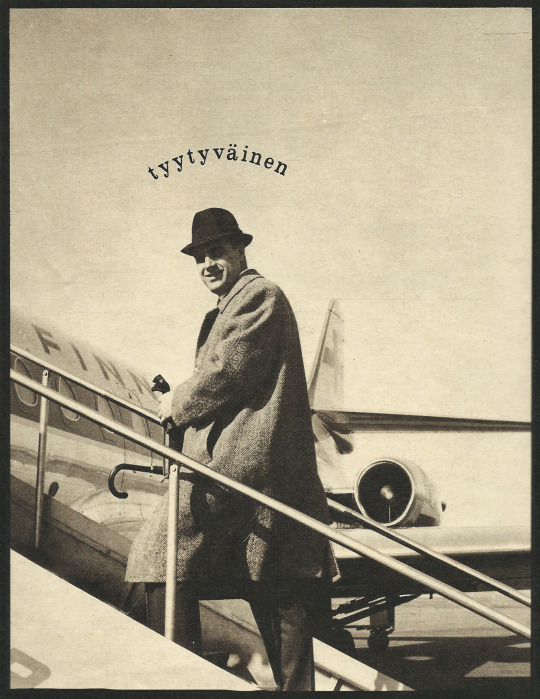
22 notes
·
View notes
Text
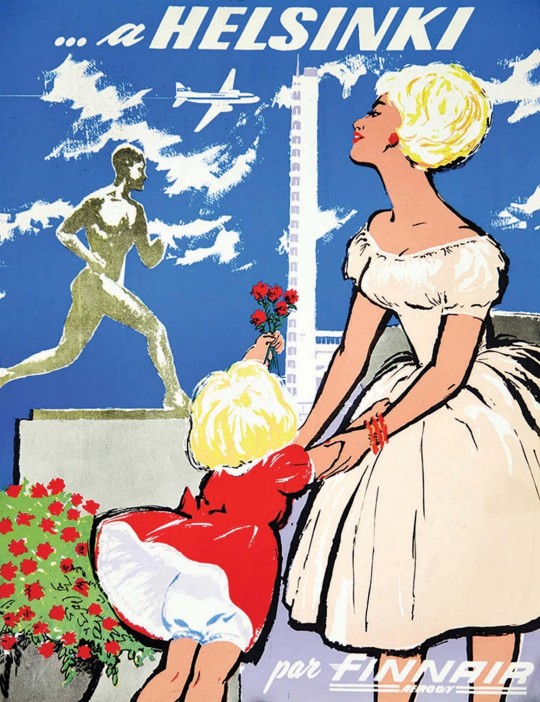
1960 … a Helsinki par Finnair
Source: Pinterest / fabienne jerot
Published at: https://propadv.com/airlines-poster-and-ad-collection/finnair-poster-and-ad-collection/
16 notes
·
View notes
Text
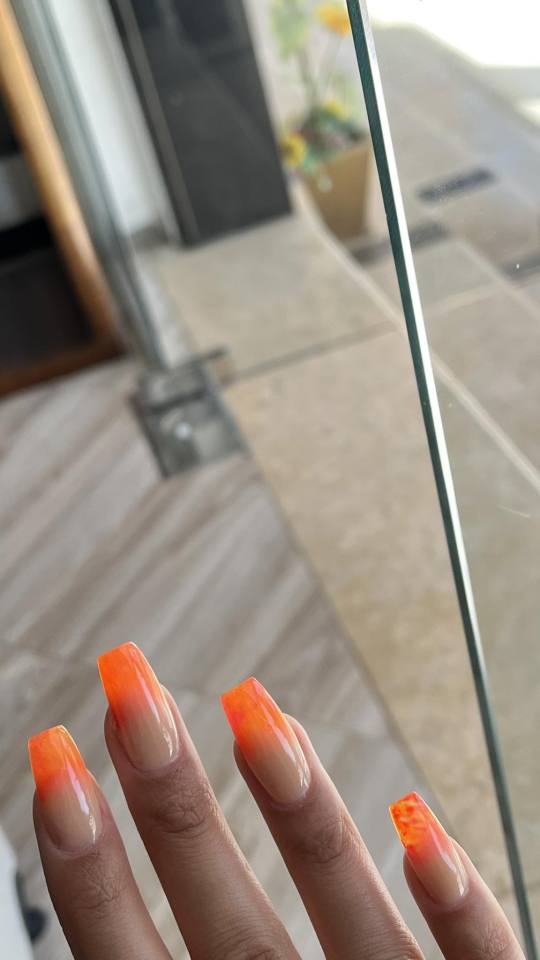
11 notes
·
View notes
Text
4 notes
·
View notes
Photo
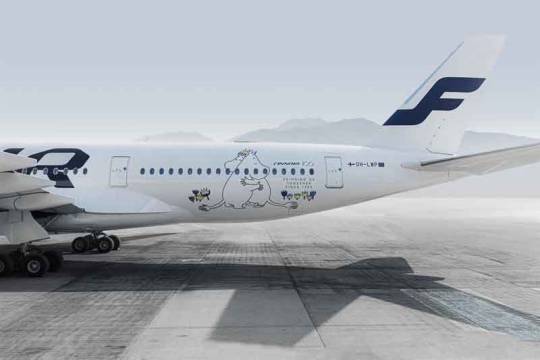
New Post has been published on https://planetalking.co.uk/win-two-business-class-tickets-to-tokyo-or-helsinki-with-finnair-and-moomins-finnairmoomin/
Win two Business Class tickets to Tokyo or Helsinki with Finnair and Moomins #finnairmoomin

#finnairmoomin#Finnair#Finnair 100 years#finnair a350#Moomins#Moomintroll#Win two Business Class tickets#Airline News#airline news#airline-news#Featured#Latest News
9 notes
·
View notes
Text

Kovat on vaatimukset lentoemoille...
9 notes
·
View notes
Text
Moving, in Japan
I flew back from Tokyo on Tuesday and I’m only now adjusting to the time difference.
Jet lag hit me super-hard this time round, but I’m finally over it. I think.
As predicted, I walked a lot. I actually think that’s an understatement. While in Japan, we visited Osaka, Kyoto, Miyajima, Hiroshima and Tokyo and waked an absolute ton while we were there. The weather was fantastic for April, with…
View On WordPress
2 notes
·
View notes
Text
No. 48 - Eurowings
We're here today to talk about Eurow

Yes, Eurowings! Did you think those five letters started any other words? Silly. Let's discuss the aerosartorial choices of Eurowings, a member of - oh dear - the Lufthansa Group.
Eurowings! Eurowings is a former regional airline formed from the 1990 merger of Nürnberger Flugdienst, a regional airline that I'd heard of, and Reise- und Industrieflug, one I hadn't. After its acquisition by Lufthansa, it has been restructured into a low-cost subsidiary, making it something of the FlyDubai of Germany. That means I am yet again courting a C&D from the Lufthansa Group, and I am delighted to throw myself on this particular blade.
The process of Eurowings's evolution into its current state is somewhat tortuous, involving the cannibalization of its old subsidiary Germanwings (yes, this was subsidiary-ception, and while it happened after 2015 it seems to have been planned before...well, you know) and the establishment of an Austrian subsidiary which was moved to Malta last year and is named - get this - Eurowings Europe.
Eurowings has been going through it of late. Well, of ever, as far as I can tell. If you've ever been frustrated by a delay, spare a thought for the passengers of 2016's Eurowings flight 131, some of whom had their visas expire while stuck in their hotels in Cuba during their 60-hour delay. Every fourth flight could expect six hours or so of unscheduled quality time at the airport. Or, you know, 20 sometimes. 20 hours. Yikes! That's what happens when you start seven long-haul routes with one (1) A330 and a handful of various and sundry wet leases. A lot of their routes have been taken over by Lufthansa proper, which seems eager to kill the brand as soon as possible, and I can't blame them given it's somehow developed a worse reputation than actual Lufthansa. I've never flown with them. They served Boston for literally three entire months, but I wouldn't have flown Eurowings anyway. For my own taste their 'cheap' prices are still fairly expensive.

The Eurowings livery is unfortunately on more than just one plane for the moment. They have 95 A320 family members and four wet-leased Boeing 737s, giving them a very typical fleet for a low cost carrier. And they look like that!
Okay, first and foremost, I want to talk about their logo. It looks a lot like LATAM's logo.

Indeed, they even both use a variation on something adjacent to blue and something adjacent to pink. I think it's definitely a coincidence - they both were unveiled in 2015 - and even if it weren't I don't respect either one enough to defend its honor from the other.
So, those colors. I think I prefer the shades chosen by Eurowings, and in a competent livery design that palette could be extremely effective. I love LATAM's saturated pink and indigo, which made the mostly-white fuselage a disappointment, and I like Eurowings's desaturated fuchsia and cyan as a combination even more, but the lack of fuselage coverage gets even sadder when it's such light colors that fail to contrast against the white at all.

Unlike LATAM, Eurowings makes use of grey as both shading and background. I like this! I think it can make for a nice base to play with and a potential source of some interesting, dynamic designs.
Oh, and the logo is meant to look like an 'E'. I guess I can sort of see it, but it looks more like me attempting to get a pen that's starting hard going again. (Don't mix inks in pens, though. Especially not fountain pens.) Anyway, I don't really love the logo's shape in isolation but I do think it could easily lend itself to some totally acceptable fuselage layouts.
It's the wordmark that I think is interesting. This is about to be a long section about fonts but I promise that one, I have a point, and two, if you keep scrolling it will stop being about fonts.

The typeface used for the Eurowings wordmark is Soleto in medium weight. It was designed by Dalton Maag, a London-and São-Paulo based foundry. You've definitely seen their work around - they've done custom fonts for the likes of Pitney Bowes, Tesco, Fox Sports, Nokia, AT&T, Airbnb, Wix, USA Today, Google, and the flipping BBC, among others. And, well, a few that I would go as far as to say are pretty iconic:


Lush Handwritten is actually gorgeous in Cyrillic, by the way.
I would say they're not my favorite foundry, with a lot of their work trending towards somewhat boring sans-serifs that are not at all to my taste (you will never replace Gill Sans), but they've had some hits. They're also no stranger to airlines - they did a custom typeface for the TUI wordmark, which appears on their livery!

Blue side up appeal aside, I definitely want to someday talk about the strange beast which is TUI, the World's Most Misogynistic Airline.
So you might think that Dalton Maag was commissioned to make a nice custom font family for Eurowings, given Lufthansa literally used their money to commission a slightly different version of Helvetica, but you would be wrong. As their website makes no mention of a custom typeface for Eurowings, despite discussing modified versions of their existing products for other companies (like Fox Sports Cricket being a variant of Aller), I believe they are indeed using off-the-shelf Soleto, available via Dalton Maag's website as well as Adobe Fonts. Now, there is nothing inherently wrong with this, and I, who cannot afford a tablet to redesign the Eurowings livery, am not trying to wealth-shame an airline for not custom-ordering a typeface. They're far from alone. Another Dalton Maag user is Cebu Pacific, which uses Foco in a bold weight to decent effect, and I firmly believe that there's no reason to commission a second Helvetica if you want to use Helvetica. SAS uses Rotis Sans, and that's a massive airline with money to spare.

I just think the contrast here is funny. I could get the right to use the full Soleto font family for the entirety of Runway Runway's branding, title, and body text for one thousand sterling, or around $1350 in USD. This is, to me, a fortune and more money than I've had at any one time in literal years. It's also definitely not what Eurowings paid. I don't know what they paid, because Dalton Maag does custom quotes for unlimited licenses, but I don't want to imagine how much it cost to commission a firm to make a second Helvetica, so this just makes me think that Lufthansa really despises Eurowings. Pointless diversion? Maybe. I just think it's funny.
I think Soleto Medium is on the uglier side. I mean, I really don't like how Eurowings uses it in the same way I don't like Helvetica or the FedEx proprietary font - I really don't like really wide sans serifs used as titling, and I'm not sure why. Is it because it reminds me of elementary school? Is it because I find them sort of illegible? Are they just...ugly? Well, there's no such thing as objective ugliness, but this is my blog and I dislike them. They're certainly not at all memorable, which frequently makes their use something of an epic branding fail.
Soleto looks better than Helvetica, I'll give it that. A lot better. It's not really the typeface, though. It's the usage. While Dalton Maag's website does say:
Soleto is a flexible font family that can adapt itself to a wide variety of uses. [...] [it] is also quite capable of standing on its own.
It opens with:
Soleto is a contemporary sans serif font family with a quietly confident character. It works well for big areas of text, creating an even rhythm and texture, but can also make a statement at larger sizes.
And I think this is totally true, actually. As body text Soleto is fine! (This is via Dalton Maag's TypeTester feature, as are all future samples.)

This is 10pt Soleto medium, and it's a solid if generic sans-serif. Not overly ugly, totally legible. I'm not sure it's meant to be used for a logo, though. When I read 'statement at larger sizes' I think...titling, not airplane livery. A title for a website and an airplane wordmark are just different orders of magnitude.
How about titling? Well, I tried my own name in a couple different weights, and I actually think Soleto looks great in black italic.

This is a bit modern for my own taste, but I think this would look fine as a wordmark. Frankly, I think it would look good as an airline livery! It's not nearly as generic, it's almost a bit stylized even, and it's legible. The italic is always something I think looks nice due to its aerodynamic implications, and with a name as long as mine you don't really notice that this also does that obnoxious thing where the bottoms of certain letters dip beneath the baseline. Let's try some other weights!


Normally I prefer lighter weights in sans serifs, but no, Soleto looks worse the thinner it gets. These are, respectively, Light and Medium. Medium is what Eurowings uses!
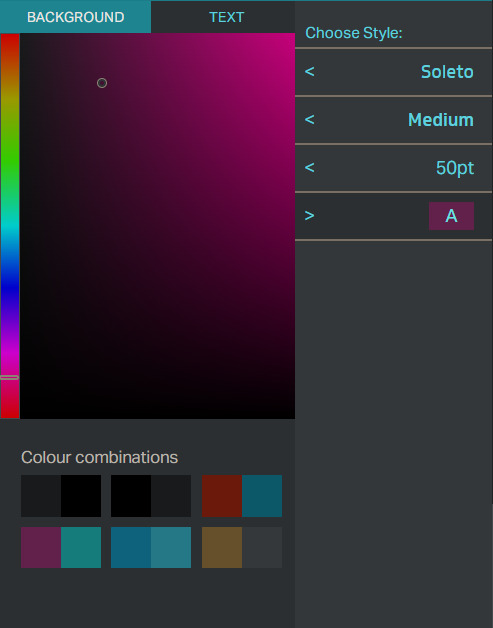
Oh, wow, would you look at that! One of their default color combinations is even basically the Eurowings scheme, though in reverse.

Well, this...doesn't look that bad, right? It's boring, but it doesn't actively make me wrinkle my nose.

So why is this such a problem? I mean, let's look at this picture of an airplane, as we do on this blog. I've chosen this picture because you can see a Finnair (post coming soon) plane in the background. Finnair has this neat spiky sci-fi looking wordmark, for which no typeface exists. This wordmark is absolutely huge, and in a very dark blue against white.
Meanwhile, Eurowings's logo is very similarly formatted to Lufthansa's. It's high up and closely spaced, making it feel a little claustrophobic. It's not...as bad as Lufthansa's proprietary Helvetica (Helvetica Neue Neue? Helvetica Ultra-Ultra-Condensed? Hellvetica?) but that's barely a compliment. Lufthansa has theirs well above the window-line all squished together, while Eurowings has the decency to use the windows as the underline you would think they're just perfect to be, but with a typeface that's medium weight, neither thick nor thin and with no italics or serifs, it becomes something of a small blob. To locate something that far up should be a stylistic choice. There should be no default choices in airline liveries. You can design a massive wordmark to cover the fuselage, or something which looks nice when localized to part of it, but you don't just get to do the equivalent of opening your text editor, typing in one word without indenting, and calling that a livery. Lufthansa doesn't get this, and neither, really, does any of the unfortunate airlines in the Lufthansa Group.
The color used doesn't blend into the white, but it also isn't like they're sharply contrasted. It just doesn't particularly draw your eye. It's a wordmark your eyes glide right over and it's not at all memorable. While grey or cyan could have been incorporated somehow to accentuate it, they weren't. For a livery that's mostly white to work, you generally need some sort of really vivid color. Kalitta Air's red and gold or Tibet Airlines' rainbow are examples of good use of a white fuselage. You could use a different background, but they stand on their own, and the white plays an active part in the color palette rather than just being a default canvas for it. Many airlines use black or dark blue for their wordmarks, and while these aren't the most creative choices they're used for a reason. Just look at Finnair. That's some contrast. It's nice and legible and distinct.
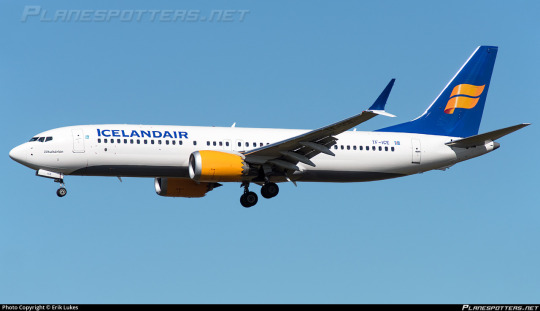

Icelandair's two most recent liveries use the same placement for their wordmark as Eurowings and Finnair respectively. Now, I actually like the wordmark on the old livery better. It has those nice trailing serifs and is in small caps, making it memorable and dynamic, and it doesn't feel closely spaced. The name 'Icelandair' teeters on the edge of being too long for this to work, but ultimately pulls it off. The modern livery dispenses with this much nicer font in favor of gigantic letters. While I like this less, it's still serviceable. It is gigantic, legible, and feels as natural as me sprawling out on a couch after work. It's simply expanded to its natural point. Adequately done on both archetypes.

Meanwhile, the lack of color contrast from the white fuselage was perhaps my main criticism of Air Astra's livery, which I otherwise quite like. It's probably the inverse of Eurowings, which is contrasted enough to be acceptable but entirely boring in design - well-designed, but please, please, please let me actually see it.

Eurowings just...well, I'm going to copy and paste exactly what I said earlier. There should be no default choices in airline liveries. You can design a massive wordmark to cover the fuselage, or something which looks nice when localized to part of it, but you don't just get to do the equivalent of opening your text editor, typing in one word without indenting, and calling that a livery.
And, as a final note, something that looks good on a webpage won't always look good on an airplane. The angles you'll see it from are completely different, it has to compete for the rest of the livery for your attention, and you can't necessarily put infinite space around it due to the very physically limited canvas you're working with. The Eurowings wordmark feels vertically cramped more than it does horizontally, because the windows are right below it and immediately above it the fuselage just...ends, from a two-dimensional view. Something looking okay in copy doesn't mean you can transfer it immediately to material.
Lindon Leader talked about this when discussing his design process for the FedEx logo in a very illuminating interview I cited heavily in my FedEx post. He looked at multiple pre-existing fonts but decided to create a custom one, and one of his reasons for this was:
[...] each had its potential limitations downstream in application to thousands of FedEx media, from waybills and embroidered courier caps to FedEx.com and massive signage for aircraft, buildings and vehicles.
Something can look acceptable or even sleek on a webpage, and that same wordmark can look downright horrible when applied to an airplane. I'll say this for FedEx - while I find their logo ugly it is absolutely good at what it needs to do. It looks no worse in any one medium or context than any other, and that's one of the reasons it's successful. It's not to my taste, but it's definitely well-designed, and I think one of the ways to improve the livery would actually be to somehow give it more real estate on the fuselage.

So the wordmark is, in my opinion, an abject failure. It's not even ugly but I mean that in the same way Wolfgang Pauli describes crackpot physics as not even wrong. Like, it's fine. It's nothing showstopping or even memorable enough to be picked out of an identity parade of default webfonts but I don't despise it. It's a common phenomenon and I'm picking on Eurowings because it's there and I know exactly what font was used and thus can mess around with it, not because it's the worst. Much like Lufthansa, it's an opportunistic victim. You know, the sort of post I'll end up hyperlinking to later, because even in its failure it's nothing exceptional.

I will say I enjoy the tiny outline of black on the letters. That's not on the wordmark proper, as rendered on their website m, but adding it was definitely the right move to help the magenta stand out from the white. Once you know about it you can notice how it makes the wordmark pop ever so slightly, turning an unmitigated catastrophe into a mitigated catastrophe. It's almost infuriating that they did this thoughtful little thing when you zoom out and remember what it's in service of. This honestly is a reoccurring thing with Eurowings.
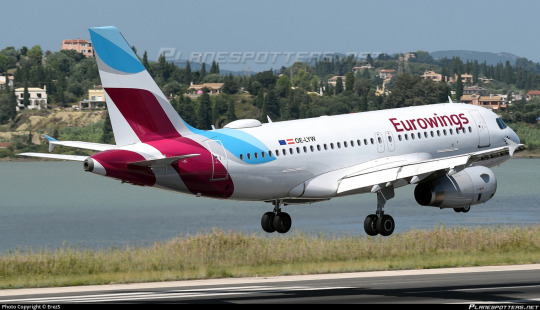
Look at that nice tail design! They could have slapped the logo on and left it at that, like so many other airlines, but they didn't. They use the same nice colors and the overlapping greys to create a design that is clearly their logo while also being abstract and dynamic. There's a lot of shapes, a lot of motion, and a lot of nice shades of cyan and magenta, and I love it!
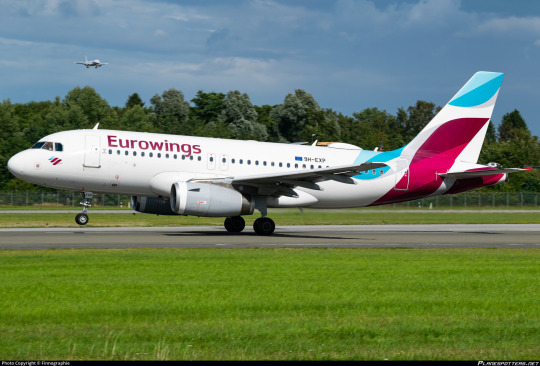
See that airplane landing in the background? Think about what airline you think it flies for, and stick a pin in that for a minute.
Hey, uh...where's the rest of it, though?
So, yes. Eurowings shares the first five letters of its name with Eurowhite. If you're not familiar with the term (I have a glossary, by the way) it just means a livery that is almost completely white save for logos. One could argue that the fact that the pattern on the tail isn't limited to strictly the tail and does form some sort of attempt at a fuselage design means that Eurowings' livery isn't 'true' Eurowhite, but I'm not going to brook that. Eurowhite is a state of mind. There is a nice, abstract design here which could easily be extended further. There is a grey shade which could be utilized (as it is on the engines, which look like they're lost and wandered onto another livery by accident) and there are infinite ideas to be had on the planet, and instead the majority of the plane is just white.
If one thing is thought of as my thesis from this post, let it be this, said for the third time: there is no such thing as default. Things like this wordmark placement, this type of font, and the primarily white fuselage are not default. The fact that they are common and boring does not make them inherent until replaced. They are still an active choice just as much as designing a livery that doesn't utilize these features is. It was proposed, iterated on, signed off on, and implemented. Airlines don't start with a template they then alter. They start with a vast world of infinite possibilities and decide they want to do the same thing as everyone else - that's a choice just how any other act of cowardice is a choice. I think the misconception that boring design is a result of inertia and lack of effort is a harmful one. It is a choice. They choose to do this.
They do not choose it because it is right for their livery, because they like it. They choose it because it is common, it is safe. It is reliable and it doesn't rock the boat. I've said this before discussing Southwest and Flair - low-cost carriers should be willing to rock the boat. If you're going to advertise yourself as the no-frills option you shouldn't try to look all composed and corporate. You have nothing to lose with being bright and pretty and interesting, so why aren't you?
And that cowardice is what makes me hate it so much. Some liveries are ugly, and some are almost ugly but stop halfway to cower in a Eurowhite bunker in an attempt to stem the bleeding, but there's nothing more tragic than a livery so afraid of being ugly that it cuts off and cauterizes something beautiful. The fear of ugliness is the death of beauty. condor is worth one billion Eurowings.
(No, Eurowings does not fail the Star Alliance Test, though.)

Like many of these designs that sort of just decide to stop after the tail, the longer a plane is the worse the Eurowings livery is on it. This is a very nice tail attached to a big white tube. Sure, Eurowings mostly operates somewhat short aircraft, but that wasn't the case when the livery was designed - back then they had A330s. Even now they have A321s.
Frustratingly, given how much I've ragged on this livery, I do still really like the tail. Even more frustratingly, you can see how easy it would have been to not have it be this way. The end of the cyan stripe almost begs to be held onto, weaved onto the rest of the fuselage, but it just isn't. It looks unfinished. It looks sad.


With all these shades of cyan and magenta to play with, the light heavily alters the way the colors on the tail look. They're never not pretty. It's a lovely colorscheme that's dramatically underutilized. The way it weaves together has so much potential, and it's attached to a white body. It looks like the paint job is unfinished. And that's what I hate the most about Eurowhite - good ideas left to languish, where a bit of custom letterhead does a better job of expressing your identity than an airplane livery.

The one feature Eurowings has towards the front of the plane is this little cheek decal of the Eurowings logo. Nice thought, but it almost looks actively worse when it stands out like that among an otherwise blank space. Plus, it's so small it might as well be a dot. It's cute, but in terms of overall effect on the livery it has the effect of making something mostly white look cluttered, which is just downright bizarre.

Obviously I can't endorse this. While not quite at the Lufthansa Line, with the actual bit of design happening on the tail instead of a sterile block, it doesn't cover much more fuselage than a proper exemplar of the phenomenon, and that's just always going to be a bit of a kneecap. Eurowhite is a state of mind, so much so that I almost think an unremarkable sans-serif font is as much of a codifying feature as a white body despite not being specified anywhere in the term. The same decision-making process leads both places, and the little black outline and cheek stamp and nice tail design just cant overpower that.
I'm giving Eurowings a D+.
Eurowings reminds me most of Saudia. They both have gorgeous colorschemes wasted on a design which burrows itself down as far into the substrate of artistic cowardice as physically possible. It's especially tragic and leaves me fighting myself over my final ratings. It feels wrong to grade such a gorgeous tail so harshly, but the good design features just make the bad package even more insulting. And at the end of the day I just have to put my foot down.
Sometimes I'm generous with grading because an airline is new, or because they're iterating on something that could be taken in a good direction. Eurowings isn't in the process of developing towards something nice, it's just Eurowings. It's an airline that stranded people in Cuba for 60 hours and Lufthansa seems to want it dead. I don't think we'll be getting a Eurowings livery overhaul anytime soon and I'm pessimistic about its longevity in general. Low-cost carriers and subsidiaries of large airlines are both easy come, easy go. Tears in the rain. 'Twas ever thus. Try not to get too attached.
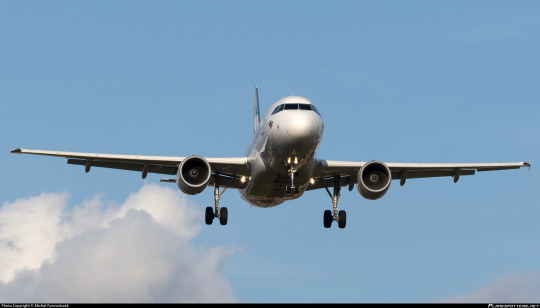
Remember that plane from earlier? Yeah, I've got no clue what airline it flies for, but I don't think I can rule out it being Eurowings. 'Twas ever thus.
#tarmac fashion week#grade: d+#era: 2010s#era: 2020s#region: west/central europe#region: germany#eurowings#low-cost carriers#lufthansa group#air astra#icelandair#lufthansa#tui#finnair
15 notes
·
View notes
Text
Received the Northern route diploma from Finnair - flew ICN-HEL over the North pole back in January.

6 notes
·
View notes
Text
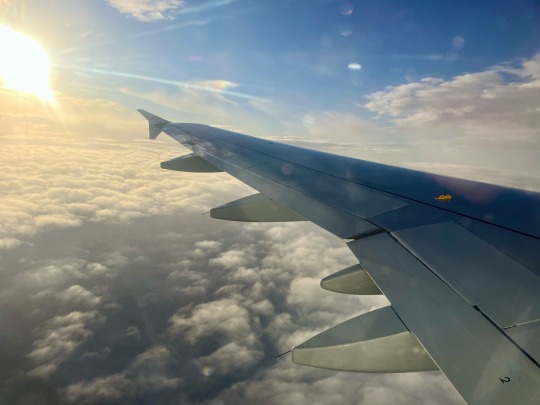
Pfiade München…
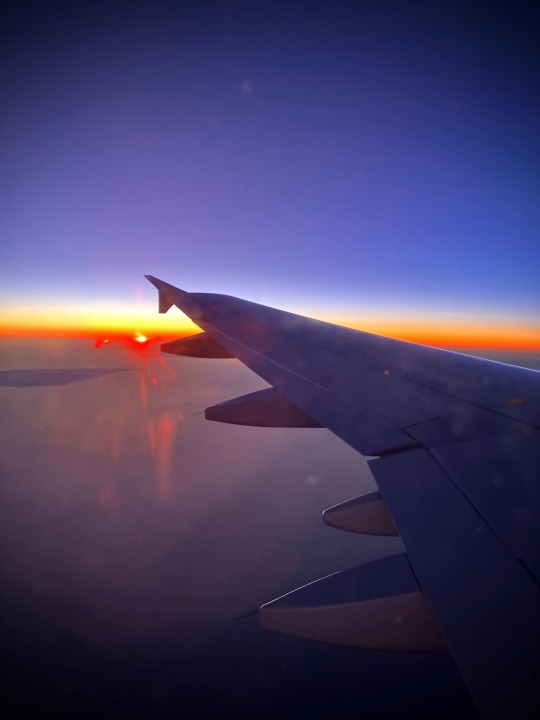
… hallo Helsinki!
#2.April#AufdemWegnachJapan#überdenWolken#Finnair#Moominvalley#ZwischenstopHelsinki#wolkigmitAussichtaufMinus2Grad
6 notes
·
View notes
